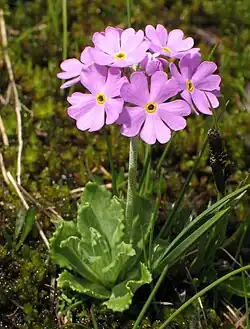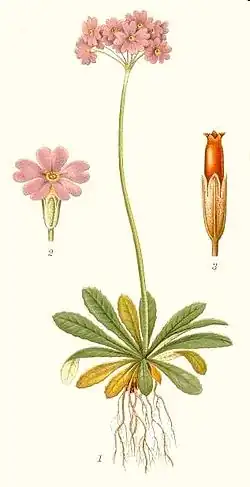Primula farinosa
| Primula farinosa | |
|---|---|

| |
| Between Gebidum Pass and Blausee in Valais, Switzerland | |
| Scientific classification | |
| Kingdom: | Plantae |
| Clade: | Tracheophytes |
| Clade: | Angiosperms |
| Clade: | Eudicots |
| Clade: | Asterids |
| Order: | Ericales |
| Family: | Primulaceae |
| Genus: | Primula |
| Species: | P. farinosa
|
| Binomial name | |
| Primula farinosa | |
| Synonyms[2] | |
|
List
| |
Primula farinosa, the bird's-eye primrose, is a small perennial plant in the family Primulaceae, native to Northern Europe and further south at high altitudes in the mountains of southern Europe. It is also widespread in northern and central Asia. This primrose thrives on grazed meadows rich in lime and moisture.
Description
Bird's-eye primrose is a herbaceous plant with a flowering stem that may reach 20 centimeters (8 in). However, like all primulas its leaves are all basal, attached directly to the base of the plant. Their leaves can measure 1 to 10 centimeters (0.4 to 3.9 in) long by 3 to 20 millimeters wide. Their shape ranges from oblanceolate to elliptical with a wide angled end and smooth or finely toothed edges. Plants can be farinose, covered in powder, or lack it, but are usually at least farinose on the underside of the leaves.[3] The mealy powder ranges in color from white to sulfur.[4]
The inflorescence it atop a scape, a leafless stem, that will measure 3 to 20 cm tall with two to twenty flowers. The flowers are between 8 and 16 mm in diameter and are usually lilac-pink, but can occasionally be white or purple.[3]
Taxonomy
Primula farinosa was given its scientific name by Linnaeus in 1753. It is classified as part of the genus Primula in the family Primulaceae.[2] It is a diploid species that is most closely related to Primula scotica.[5] It has no recognized subspecies or varieties, but it has 29 synonyms.[2]
| Name | Year | Rank | Notes |
|---|---|---|---|
| Aleuritia farinosa (L.) Opiz | 1839 | species | ≡ hom. |
| Aleuritia farinosa subsp. alpigena (O.Schwarz) Soják | 1979 | subspecies | = het. |
| Androsace farinosa (L.) Spreng. | 1815 | species | ≡ hom. |
| Cankrienia farinosa (L.) Zoll. | 1854 | species | ≡ hom. |
| Primula altaica Lehm. | 1817 | species | = het. |
| Primula davurica Lehm. | 1817 | species | = het., nom. illeg. |
| Primula exaltata Lehm. | 1817 | species | = het. |
| Primula farinosa f. alba (H.Hara) T.Yamaz. | 2003 | form | = het. |
| Primula farinosa subvar. albiflora Druce | 1917 | subvariety | = het. |
| Primula farinosa subsp. alpigena O.Schwarz | 1968 | subspecies | = het. |
| Primula farinosa var. americana Torr. | 1824 | variety | = het. |
| Primula farinosa var. chrysophylla Trautv. & C.A.Mey. | 1856 | variety | = het. |
| Primula farinosa var. commutata Behm | 1887 | variety | = het. |
| Primula farinosa f. exscapa Wahlenb. | 1824 | form | = het. |
| Primula farinosa var. genuina Pax | 1888 | variety | ≡ hom., not validly publ. |
| Primula farinosa var. koreana T.Yamaz. | 2003 | variety | = het. |
| Primula farinosa var. leucophylla Trautv. & C.A.Mey. | 1856 | variety | = het. |
| Primula farinosa var. nana E.S.Arnold & A.J.Richards | 2002 | variety | = het. |
| Primula farinosa f. nivea (H.Hara) T.Yamaz. | 2003 | form | = het. |
| Primula farinosa var. pygmaea Gaudin | 1828 | variety | = het. |
| Primula farinosa var. stricta Wahlenb. | 1824 | variety | = het. |
| Primula farinosa subsp. xanthophylla (Trautv. & C.A.Mey.) Kitag. | 1939 | subspecies | = het. |
| Primula farinosa var. xanthophylla Trautv. & C.A.Mey. | 1856 | variety | = het. |
| Primula gigantea Lehm. | 1817 | species | = het., nom. illeg. |
| Primula lepida Duby | 1844 | species | = het. |
| Primula modesta f. alba H.Hara | 1948 | form | = het. |
| Primula modesta f. nivea H.Hara | 1948 | form | = het. |
| Primula undulata Fisch. ex Rchb. | 1827 | species | = het. |
| Primula warei Stein | 1882 | species | = het. |
| Notes: ≡ homotypic synonym ; = heterotypic synonym | |||
Range and habitat

Primula farinosa is widespread in Europe and Asia according to Plants of the World Online. In Europe it is native as far west as Spain, France, and Great Britain. It grows in central and southern Europe including Germany, Switzerland, Italy, Austria, Hungary, Czechia, Slovakia, and Poland. In northern Europe it is found in Denmark, Sweden, Finland, and the Baltic States.[2] It is listed as locally extinct in Czechia by the IUCN. In the southeast it is part of the flora of Croatia, Bulgaria, Romania, and Ukraine.[1] In European Russia it grows in the northwest, north, and east. [2] On the Novaya Zemlya archipelago it reaches 72° N.[6]
In Asia it is native as far south as the central Asian states of Kazakhstan, Kirgizstan, and Tadzhikistan. It grows in all Asian Russia from western Siberia to the Magadan Oblast and the Chukotka Autonomous Okrug. It also grows on the Russian controlled Kuril Islands. To the south it is found in Mongolia and two parts of China, Manchuria and Inner Mongolia.[2]
The species favors alkaline soils and is found in marshes, peatlands, and damp meadows.[3][4] It tends to be found in mountainous areas.[3]
References
- ^ a b Khela, S. (2012). "Primula farinosa". IUCN Red List of Threatened Species. 2012: e.T203398A2764887. Retrieved 30 January 2020.
- ^ a b c d e f "Primula farinosa L." Plants of the World Online. Royal Botanic Gardens, Kew.
- ^ a b c d Valentine, D.H.; Kress, A. (1972). "Primula". In Tutin, T.G.; Heywood, V.H.; Burges, N.A.; Moore, D.M.; Valentine, D.H.; Walters, S.M.; Webb, D.A. (eds.). Flora Europaea. Vol. 3 Diapensiaceae to Myoporaceae. Cambridge, England: Cambridge University Press. pp. 15, 17. ISBN 978-0-521-22493-2. OCLC 1301968828. Retrieved 26 June 2025.
- ^ a b Clapham, A. R. (1981). Excursion Flora of the British Isles. Cambridge ; New York: Cambridge University Press. p. 345. ISBN 978-0-521-23290-6. Retrieved 26 June 2025.
- ^ Guggisberg, Alessia; Mansion, Guilhem; Conti, Elena (1 February 2009). "Disentangling Reticulate Evolution in an Arctic–Alpine Polyploid Complex". Systematic Biology. 58 (1): 55–73. doi:10.1093/sysbio/syp010. hdl:20.500.11850/106156. ISSN 1063-5157. JSTOR 25677483. PMID 20525568. Retrieved 27 June 2025.
- ^ Feilden, H.W. (1899). "Appendix C - Flowering Plants of Novaya Zemlya, Etc.". In Pearson, Henry John (ed.). Beyond Petsora Eastward : Two Summer Voyages to Novaya Zemlya and the Islands of Barents Sea. London: R.H. Porter. p. 221. doi:10.1017/CBO9781139151658.014. OCLC 820943428. Retrieved 27 June 2025.
